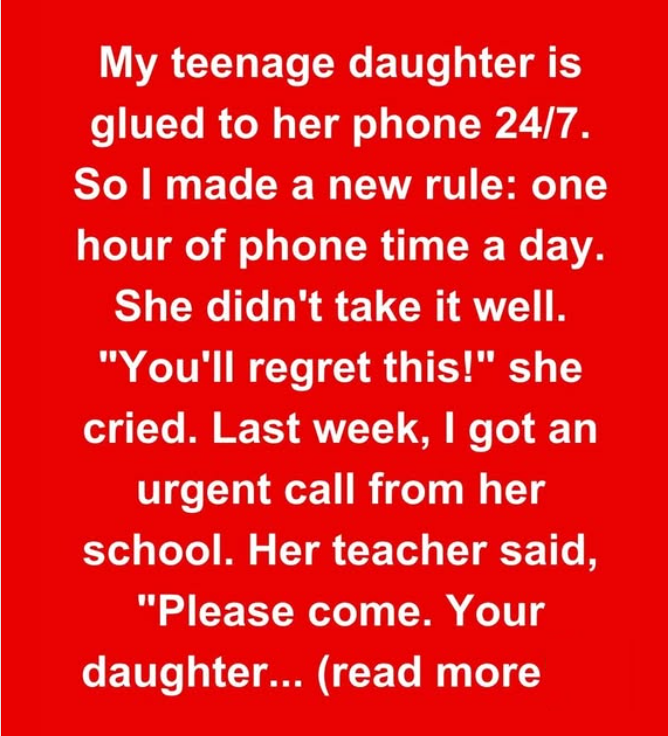My teenage daughter is glued to her phone 24/7. So, I made a new rule: only one hour of phone time per day. She didn’t take it well.
“You’ll regret this!” she cried.
Last week, I got an urgent call from her school. Her teacher said, “Please come. Your daughter needs you.”
I rushed over, heart pounding. All sorts of terrifying thoughts ran through my head—had she gotten into a fight? Was she injured? Or worse?
When I arrived, Ms. Bernal, her homeroom teacher, met me outside the counselor’s office. She looked concerned but composed.
“Mrs. Alston, please, have a seat.”
I sat down across from my daughter, Iris. She looked physically fine—no bruises, no tears—but she wouldn’t meet my eyes.
“What happened?” I asked, trying to stay calm.
Ms. Bernal sighed. “Iris has been skipping lunch. And she’s been seen crying in the bathroom more than once. Today, a classmate found her behind the gym, very upset.”
I was stunned. “Iris, why didn’t you tell me?”
She stayed silent, shoulders slumped.
Ms. Bernal continued, gently, “It looks like she’s been dealing with online bullying. When you restricted her phone, she couldn’t respond or defend herself. That’s when the bullying escalated.”
My heart dropped. I thought I was helping. I thought limiting her phone would give her peace. But instead, it cut her off from the very space where she needed to protect herself.
Eventually, Iris whispered, “They said I was ignoring them. That I thought I was better than them. They started group chats… shared edited photos… it kept getting worse.”
I held her hand, guilt crashing over me. “Why didn’t you say something, sweetheart?”
Tears welled in her eyes. “You already thought I was addicted to my phone. I didn’t want you to think I was weak too.”
That shattered me.
That night, we sat on the couch—no phones, no distractions. Just mother and daughter.
“I think I made things worse,” I admitted softly.
She shook her head. “You were trying to help. But you didn’t know everything.”
We talked for hours—for the first time in months. She told me how her “friends” slowly turned on her out of jealousy. How they excluded her, mocked her. How the phone wasn’t an obsession—it was her only line of defense.
That’s when I realized: the issue wasn’t screen time. It was what was happening on the screen.
The next day, I called the school counselor and set up regular sessions for Iris. I also reached out to the parents of the girls involved. Some were receptive. Others… not so much.
But one call surprised me—Mylene’s mom, Mrs. Tran, whose daughter had led the bullying.
“Mrs. Alston,” she said, “I had no idea. Mylene’s been struggling too. Her father and I just separated… I think she’s been acting out.”
It didn’t excuse Mylene’s actions, but it gave context.
With the counselor’s help, we arranged a supervised meeting between the girls. It was tense, emotional—but eye-opening. Mylene admitted she felt abandoned and angry. Iris, with quiet strength, stood her ground—and forgave.
“I don’t want to be enemies,” Iris said. “But I won’t let you treat me that way again.”
I had never been so proud.
Over the next few months, things got better. The bullying stopped. The school updated its policies on cyberbullying. Iris found her confidence again. She joined the debate team and made new, supportive friends.
As for the phone rule? We created a new agreement together. It wasn’t about time limits anymore—it was about trust, boundaries, and open communication.
“Mom,” Iris said one night as we cooked dinner, “thank you for listening.”
I smiled. “Thank you for giving me another chance.”
Looking back, I see it clearly now: As parents, we often act from fear, not understanding. We want to protect our kids so badly, we forget they’re navigating battles we don’t always see.
The lesson?
Don’t assume. Don’t just control. Listen.
Because sometimes, what our children need most… is to be heard.
